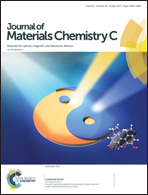Facile fabrication of homogeneous and gradient plasmonic arrays with tunable optical properties via thermally regulated surface charge density†
Abstract
A facile strategy is reported for the electrostatic self-assembly of homogeneous and gradient plasmonic nanoparticle arrays with tunable interparticle distances and optical properties. The interparticle distance is dominated by the surface charge density of the substrate, which is tuned via thermal annealing according to the temperature-dependent molecular mobility of the polymer. Oxygen plasma is employed to endow neutral polystyrene (PS) films with sufficient charges, enabling subsequent electrostatic adsorption. The density of surface charges can be readily tuned via a thermal annealing step after plasma treatment, which is confirmed by quantitative analyses of oxygen and nitrogen using X-ray photoelectron spectroscopy. Afterwards, PS films with regulated charge densities reshape the double layers around nanoparticles to various degrees during the assembly, leading to tunable interparticle separations. UV-Vis spectroscopy reveals tunable plasmonic properties owing to the critical role of interparticle separation in plasmon coupling. Here such structures are demonstrated to act as wavelength-selective substrates for multiplexed acquisition of surface enhanced Raman scattering. Alternatively, by applying a temperature gradient in the annealing step, we create a macroscopic surface with a continuous gradient in plasmonic properties. Such a “plasmonic library” can be a promising material for fast screening of interparticle distance or extinction spectrum in specific applications on one single substrate.



 Please wait while we load your content...
Please wait while we load your content...